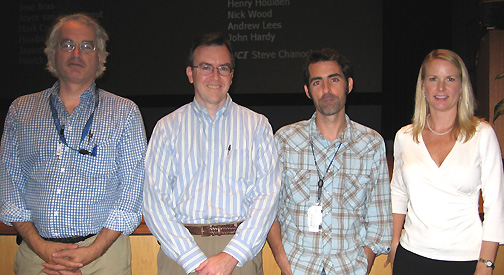
Traveling the genome: (left to right): Stephen Chanock, NCI; Francis McMahon, NIMH; session chair Andrew Singleton, NIA; and Anjene Addington, NIMH
| T H E N I H C A T A L Y S T | N O V E M B E R – D E C E M B E R 2007 |
|
|
|
Research
Festival
|
by Julie Wallace |
 |
|||
|
Traveling the genome: (left to right): Stephen Chanock, NCI; Francis McMahon, NIMH; session chair Andrew Singleton, NIA; and Anjene Addington, NIMH |
Stephen Chanock, head of the Genomic Variation Section, Pediatric Oncology Branch, NCI, is using genome-wide SNP assays to study solid tumors.
He and his colleagues are aiming to identify genetic regions associated with risk for specific cancers, such as breast and prostate cancer. The results of their initial screening of more than 540,000 SNPs prompted further exploration of a specific chromosomal region (8q24) commonly amplified in prostate tumors. Moreover, regions in a 1.5-Mb section of this locus were also implicated in breast and colon cancers—leading to the tantalizing suggestion, Chanock said, that this may be one of several master-regulator regions important in different cancers.
Chanock’s group is now extending its focus to pancreatic, lung, and bladder cancers.
Bipolar Disorder
In the realm of psychiatric diseases, where patients are diagnosed primarily by behavior, "reliability in the diagnosis does not equal validity [in molecular genetics]," and the underlying biology for each patient may not necessarily relate to their psychiatric label, observed Francis McMahon, chief of the Genetic Basis Unit, Mood and Anxiety Disorders Program, NIMH.
To limit this variable, McMahon’s lab focuses on bipolar disorder, which appears to have a strong genetic component. Using samples from the NIMH Genetics Initiative Bipolar Disorder Consortium, McMahon’s lab identified around 80 SNPs in or near genes.
In this "first look" at bipolar disorder, a significant SNP was found near the DGKH gene, a good candidate gene for mental illness that is related to lithium signaling. The study also suggested the involvement of several risk alleles in bipolar disorder, which may be the "result of many genes of small effect acting together," McMahon said.
Childhood-Onset Schizophrenia
Anjene Addington, also of NIMH, is charting the chromosomal aberrations and copy number variations in patients with childhood-onset schizophrenia (COS). She hopes to identify a homogenous group of patients less likely to have been exposed to environmental factors. Patients with early-onset disease are also thought to have a greater genetic risk and a more severe disease course. In a study of 96 children diagnosed with schizophrenia by age 12, Addington’s group identified multiple chromosomal aberrations, including a novel balanced translocation between chromosomes 1 and 7, three cases of X chromosome abnormalities, and four cases of a 3-Mb deletion on chromosome 22q11, associated with velocardiofacial syndrome.
Copy number variants—DNA segments larger than 1 kb that are present in abnormal numbers—were also higher in children with COS than their unaffected siblings (an average of 32 compared to 24). These variations suggest "general genomic instability," Addington said, but noted that it is not easy to distinguish disease-related from garden-variety copy number variations.
Homozygosity and Complex Diseases
While genotyping large numbers of Caucasian males, Andrew Singleton, an investigator in the Molecular Genetics Unit, Laboratory of Neurogenetics, NIA, and his colleagues observed large tracts of allele homozygosity in 7 percent—a finding that suggested a single origin for maternal and paternal chromosomes. Of these 7 percent, 59 percent possessed at least one homozygous region greater than 5 Mb in size. Identifying homozygous populations, Singleton said, should enhance the power of genome-wide association studies of complex traits and diseases such as Parkinson’s.